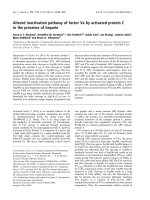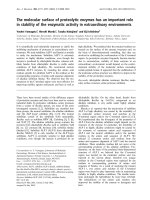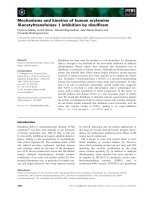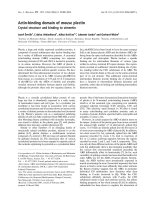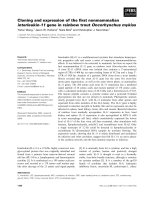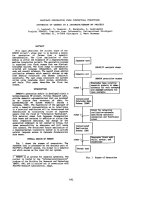Báo cáo khoa học: "LANGUAGE SYNTHESIS GENERATION OF GERMAN FROM CONCEPTUAL STRUCTURE: MT PROJECT IN A JAPANESE/GERMAN" pot
Bạn đang xem bản rút gọn của tài liệu. Xem và tải ngay bản đầy đủ của tài liệu tại đây (309.92 KB, 4 trang )
LANGUAGE GENERATION FROM CONCEPTUAL STRUCTURE:
SYNTHESIS OF GERMAN IN A JAPANESE/GERMAN MT PROJECT
J. Laubsch, D. Roesner, K. Hanakata, A. Lesniewski
Projekt SEMSYN, Institut fuer Informatik, Universitaet Stuttgart
Herdweg 51, D-7000 Stuttgart i, West Germany
This paper idescribes the current state of the
S~/~gYN project , whose goal is be develop a module
for generation of German from a semantic
representation. The first application of this
module is within the framework of a Japanese/German
machine translation project. The generation process
is organized into three stages that use distinct
knowledge sources. ~ne first stage is conceptually
oriented and language independent, and exploits
case and concept schemata. The second stage e~ploys
realization schemata which specify choices to map
from meaning structures into German linguistic
constructs. The last stage constructs the surface
string using knowledge about syntax, morphology,
and style. This paper describes the first two
stages.
INTRO[X~TION
~'s generation module is developed within a
German/Japanese MT project. FUjitsu Research Labs.
provide semantic representations that are produced
as an interim data structure of their Ja-
panese/English MT system ATLAS/II (Uchida &
Sugiyama, 1980). ~ne feasibility of the approach of
using a semantic representation as an interlingua
in a practical application will be investigated and
demonstrated by translating titles of Japanese
papers from the field of "Information Technology".
This material comes from Japanese documentation
data
bases and contains in addition to titles also
their respective abstracts. Our design of the
generation component is not limited to titles, but
takes extensibility to abstracts and full texts
into account. The envisioned future application of
a Japanese/German translation system is to provide
natural language access to Japanese documentation
data
bases.
OVERALL DESIGN CF
Fig. 1 shows the stages of generation. The
Japanese text is processed by the analysis part of
FtUI"TS~'s ATLAS/II system. Its output is a semantic
net which serves as the input for our system.
1 ~ is an acronym for semantic synthesis. The
project is funded by the "Informationslinguistik"
program of the Ministry for Research and Technology
(BM~T), FRG, and is carried out in cooc~ration with
~JJITSU Research Laboratories, Japan.
I
I .gem antic net
stage 1 ~r
ATLAS/II analysis stage
- ~ generation stages
Knowledge base relating
semantic symbols to case-
schemata for verb concept~
and amuept-schemata for #
~n ~ I
Instantiated
Knowledge Base
, Schema
(l]~)
stage 2 1
Instantiated
Realization
Schema (IRS)
I
Generator front end:
stage 3 I style, syntax, and
{ sociology
Rules for selecting
realization-schemata,
specifying syntactic
categories and functional
roles
Fig. 1 Stages of Generation
491
CONCEPTUAL STRUCTURE
ATLAS/II's semantic networks (see Fig.2)
are directed graphs with named nodes and
labelled arcs. The names of the node are
called "semantic symbols" and are associated
with Japanese and English dictionary entries.
The labelled arcs are used in two ways:
a) Binary arcs either express case relations
between connected symbols or combine sub-
structures
b) Unary arcs serve as modifying tags of
various kinds (logical junctors, syntactic
features, stylistics, )
The first stage of generation is con-
ceptually oriented and should be target
language independent, we use frame structures
in a KRL-like notation. Our representation
distinguishes between case scb~.mta (used to
carry the meaning of actions), and concept
scho-~_ta (used to represent "things" or "qua-
lities"). Each semantic symbol points to such
a schema. These schemata have three parts:
(I) roles: For action schemata, these are the
usual cases of Fillmore (e.g. AGENT, OBJECT,
); for concept schemata roles describe how
the concept may be further specified by other
concepts.
(2) transformation rules: These are condition-
action pairs that specify which schema is to
be applied, and how its roles are to be filled
from the ATLAS/II net.
(3) choices describe possible syntactic
patterns for realization.
Examples:
Case schema for the semantic symbol ACHIEVE:
(ACHIEVE (super= goal-oriented-act)
(roles
(Agent (class animate))
(Goal)
(Method (class abstract-object))
(Instrument (class concrete-object)))
(transformation-rules )
(choices )))
The concept schema for SPEAKER is:
(SPEAKER (superc animate)
( roles
(Performs-act-for (class organization))
.o.)
(transformation-rules )
(choices ))).
i) Retrieval of the lexical entry of a German
verb and its associated case frame cor-
responding to the IKBS.
ii) Selection of lexical entries for the other
semantic symbols.
iii) Selection of a realization schema (RS),
mapping of IKBS roles to RS functional
roles, and inferring syntactic features.
In i) a simple retrieval may not suffice.
In order to choose the most adequate German
verb, it will e.g. be necessary to check the
fillers of an IKBS. For example, the semantic
symbol REALISE may translate to "realisieren",
"implementieren" etc If the Instrument role
of REALISE were filled with an instance of the
PROGRAM concept, we would choose the more
adequate word sense "implementieren".
In ii) sometimes similar problems arise.
For example, the semantic symbol ACCIDENT may
translate to the German equivalent of
"accident", "error", "failure" or "bug". The
actual choice depends here on the filler of
ACCIDENT's semantic role for "where it
occurred".
iii) The choices aspect o~ a schema
describes different possibilities how an
instance may be realized and specifies the
conditions for selection. (This idea is due to
McDonald (iq83) and his MUMBLE system). The
factors determining the choice include:
(a) Which roles are filled?
(b) What are their respective fillers?
(c) Which type of text are we going to
generate?
For example if the Agent-role of a case
frame is unfilled, we may choose either
passivation or selection of a German verb
which maps the semantic object into the
syntactic subject. If neither agent nor object
are filled, nominalization is forced.
A realization schema (RS) is a structure
which identifies a syntactic category (e.g.
CLAUSE, NP) and describes its functional roles
(e.g. HEAD, MODIFIER, ). We employ
Winograd's terminology for functional gran~nar
(Winograd, 1983). In general, case schemata
will be mapped into CLAUSE-RS and concept
schemata are mapped into NP-R~. A CLAUSE-RS
has a features description and slots for verb,
subject, direct object, and indirect obiects.
A features description may include information
about voice, modality, idiomatic realization,
etc There are realization schemata for
discourse as well as titles. The latter are
special cases of the former, forcing
nominalized constructions.
FROM CONCEPTS TO LANGUAGE
In the target language oriented stage 2,
the following decisions have to be made:
REFERENCING AND FOCUSSING
For referencing and other phenomena like
focussing, the simple approach of only
allowing a schema instance as a filler is not
sufficient. We therefore included in our
492
knowledge representation a way to have de-
scriptors as fillers. Such descriptors are
references to parts of a schema. In the
following example the filler of USE'S Object-
slot is a reference descriptor to SYNTHESIZE's
Object-slot:
X = (a USE with
(Object
(the Object from
(a SYNTHESIZE with
(Object [FUNCTION])
(Method [DYNAMIC-PROGRAMMING])))
(Purpose (an ACCESS with
(Object [DATA-BASEl))))
X could be realized as:
"Using functions, that are synthesized by
dynamic programming for data-base access."
In general, descriptors have the form:
(the <path> from <IKBS>)
<path> = <slot>
A description can be realized by a relative
clause.
The same technique of referring to a sub-
structure may as well be used for focussing.
For example, embedding X into
(the Purpose from X)
expresses that the focus is on X's Purpose
slot, which would yield the realization:
"Database access using functions that are
synthesized by dynamic progra,ming."
A WALK WITH SEMSYN
Let us look at the first sentence from an
abstract. Figure 2 contains the Japanese input
and the semantic net corresponding to
ATLAS/II's analysis.
In stage i, we first examine those semantic
symbols which have an attached case schema and
instantiate them according to their trans-
formation rules.
In this example the WANT and ACHIEVE nodes
(flagged by a FRED arc) are case schemata.
Applying their tranformation rules results in
the following IKBS:
(a WANT with
(Object
(an ACHIEVE with
(Agent [SPF2~KER])
(Object [PURPOSE (Number [PLURAL])])
(Method
[U'~'I'ERANCE
(Number [SINGLE])])))
In stage
2, we
will derive a description of
how this structure will be realized as German
text.
First, consider the outer WANT act. There
japanese input
for FUJITSUs
RTLRS/II-systeR
Top o,I" obicct
SEMSYHs interface to RTLRS/II
((UTTERANCE HUMBER-> ONE) (PURPOSE ~R-> PLURAL)
(MRNT OBJ-> RCHIE~)
(~T-"PRE~-> =NIL)
(ZNIL
ST-> gRNT)
(ACHIEVE OBJ-> PURPOSE)
(RCHIEUE PRED-> ¢NIL)
(ACHIEVE IIETHOD-> UTTERANCE)
(RCHIEVE ~RGENT-> SPERKER))
,~otto.t of object
;EMRHTIC NET
Top oy object
GERMAN EQUIVALENT TO JAPANESE INPUT
ES WIRD GEWUENSCHT DASS EIN
SPRECHER MEHRERE ZWECKE MIT
EINER EINZELNEN AEUSSERUNG
ERREICHT
#o#~m o,f object
Figure 2. From Japanese to German
is no Agent, so we choose to build a clause in
passive voice. Next, we observe that WANT's
object is itself an act with several filled
roles and could be realized as a clause. One
of the choices of WANT fits this situation.
Its condition is that there is no Agent and
the Object will be realized as a clause. Its
realization schema is an idiomatic phrase
named *Es-Part*:
"Es ist erwuenscht, dass <CLAUSE>"
("It is wanted that <CLAUSE>")
Now consider the embedded <CLAUSE>. An
ACHIEVE act can be realized in German as a
clause by the following realization schema:
493
(a CLAUSE with
(Subject <NP-realization of Agent-role>
(Verb "erreich "
(DirObj <NP-re~lization of Object-role>
(IndObjs
(a PP with
(Prep (One-of ["durch" "mit" "mittels"]))
(PObj <N-P-realization of Method-role>))))
This schema is not particular to ACHIEVE.
It is shared by other verbs and will therefore
be found via general choices which ACHIEVE
inherits.
The Agent of ACHIEVE's IKBS maps to the
Subject and the Method is realized as an
indirect object. Within the scope of the
chosen German verb "erreichen" (for
"achieve"), a Method role maps into a PP with
one of the prepositions "dutch", "mit",
"mittels" (corresponding to "by means of").
This leads to the following IRS:
(a CLAUSE with
(Features (Voice Passive
Idiom *Es-Part*)
(Verb "wuensch_") ;want
(DirObj
(a CLAUSE with
(Subject (a NP with
(Head "Sprecher")));speaker
(Verb "erreich")
(DirObj
(aNP with
(Features (Numerus= Plural))
(Head ["Ziel", "Zweck"]) ; purpose
(Adj "mehrere")) ; multiple
(IndObjs
((a PP with
(Prep ["durch", "mit", "mittels"])
(PObj
(aNPwith
(Features (Numerus Singular))
(Head "Aeusserung") ;utterance
(Adj "einzeln") ; single )))))
Such an instantiated realization schema
(IRS) will be the input of the generation
front end that takes care of a syntactically
and morphologically correct German surface
structure (see Fig. 2).
EXPERIMENTS WITH OTHER GENERATION MODULES
We recently studied three generation
modules (running in Lisp on our SYMBOLICS
3600) with the objective to find out, whether
they could serve as a generation front end for
SEMSYN: SUTRA (Busemann, 1983), the German
version of IPG (Kempen & Hoenkamp, 1982), and
MUMBLE (McDonald, 1983).
Our IRS is a functional grammar descrip-
tion. The input of SUTRA, the "preterminal
structure", already makes assumptions about
word order within the noun group. To use
SUTRA, additional transformation rules would
have to be written.
IPG's input is a conceptual structure.
Parts of it are fully realized before others
are considered. The motivation for IPG's
incremental control structure is psycho-
logical. In contrast, the derivation of our
IRS and its subsequent rendering is not
committed to such a control structure. Never-
theless, the procedural grarmnar of IPG could
be used to produce surface strings from IKBS
by providing it with additional syntactic
features (which are contained in IRS).
Both MUMBLE and IPG are conceptually
oriented and incremental. MUMBLE's input is on
the level of our IKBS. MUMBLE produces func-
tional descriptions of sentences "on the fly".
These descriptions are contained in a
constituent structure tree, which is traversed
to produce surface text. Our approach is to
make the functional description explicit.
ACKNOWLEDG~4ENTS
We have to thank many colleagues in the
generation field that helped SEMSYN with their
experience. We are especially thankful to Dave
McDonald (Amherst), and Eduard Hoenkamp
(Nijmegen) whose support - personally and
through their software - is still going on. We
also thank the members of the ATLAS/II
research group (Fujitsu Laboratories) for
their support.
REFERENCES
Uchida,H. & Sugiyama: A machine translation
system from Japanese into English based on
conceptual structure, Proc. of COLING-80,
Tokyo, 1980, pp.455-462
Winograd, T.: Language as a cognitive process,
Addison-Wesley, 1983
McDonald, D.D.: Natural language generation as
a computational problem: An Introduction; in:
Brady & Berwick (Eds.) Computational model of
discourse, NIT-Press, 1983, pp.209-265
Kempen, G. & Hoenkamp,E.: Incremental sentence
generation: Implication for the structure of a
syntactic processor; in Proc. COLING-82,
Prague, 1982, pp.151-156
Busemann,B.: Oberflaechentransformationen bei
der Generierung geschriebener deutscher
Sprache; in: Neumann, B. (Ed.) GWAI-83,
Springer, 1983, pp.90-99
494
